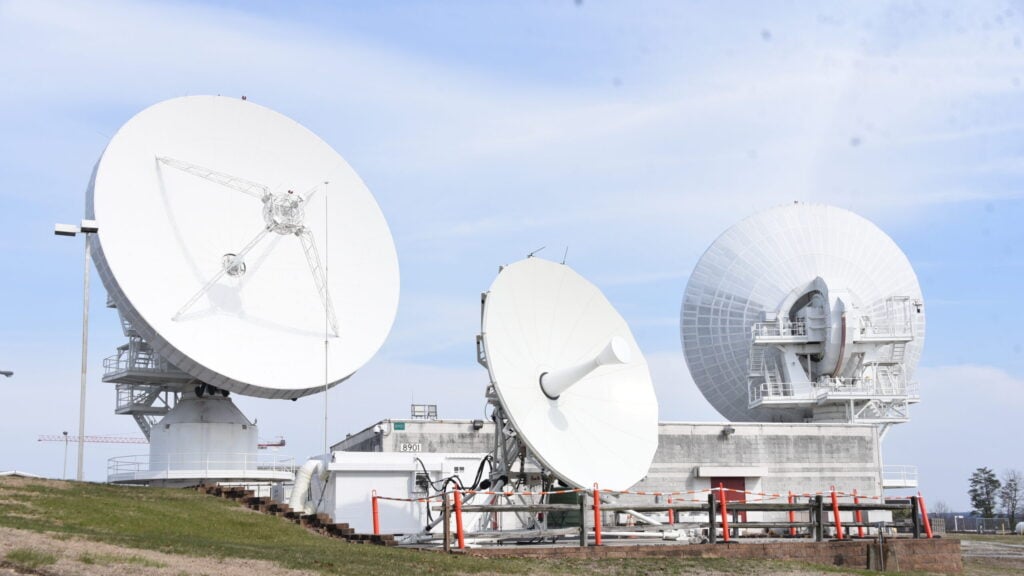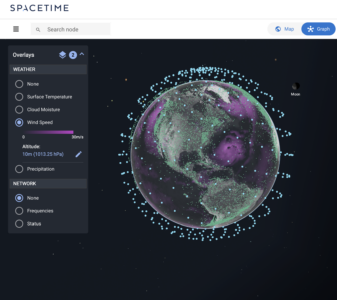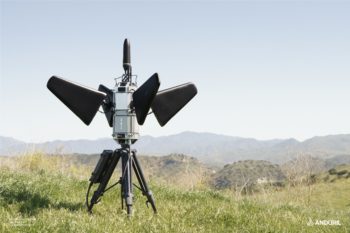
The US Army Satellite Operations Brigade’s Wideband Satellite Communications Operations Centers, like the one pictured here at Company B, Fort Meade, Md., manage the payloads and provide critical communications, navigation and other space-based capabilities to warfighters. (US Army photo by Carrie David Campbell)
WASHINGTON — As part of a contract with the Pentagon’s Defense Innovation Unit (DIU), startup network firm Aalyria has successfully demonstrated its novel “Spacetime” software for managing communications flow among a number of Defense Department and commercial satellites, according to company officials.
“We are about to receive our ‘letter or success,’ which will allow us to move from a prototype OTA [Other Transaction Authority contract] to a production OTA,” CEO Chris Taylor told Breaking Defense in an interview. “We believe we know who our capability will transition to but I can’t share it because it’s not done yet.”
Taylor said that the demonstration in December at the Naval Research Laboratory (NRL), was a first of its kind, and proves that both DIU’s concept of a Hybrid Space Architecture and the Defense Department’s plans for Combined Joint All Domain Command and Control (CJADC2) are doable.
A future Hybrid Space Architecture would link commercial and military satellites to create a jam-resistant internet in space. CJADC2 is the Pentagon’s term of art for tying allies into its planned sensor-to-shooter communications network to allow near-real time targeting in next-generation conflict.
“I think that the demonstration that we did showed many leaders who are working on really hard problems that the way they’re thinking about things is the right way to think about things, and it can also be done,” Taylor said.
DIU didn’t respond to a request for comment.

Aalyria’s Spacetime being utilized in a demo held at the Naval Research Lab in Washington, DC (Screenshot: Aalyria)
During the demo, “Aalyria’s Spacetime network orchestration software platform was used to operate a multi-vendor, multi-operator, multi-orbit SATCOM network across secure Department of Defense (DoD) and multiple commercial provider locations,” the company said in a press release today. The satellites were linked to ground stations, receivers and airborne platforms.
“Spacetime demonstrated reallocation of network resources and reconstitution of connectivity services within seconds in response to the unexpected loss of a satellite, introduction of jamming effects, outages to terrestrial fiber, and dynamic changes to end-to-end data rate, latency, and priority requirements,” Aalyria’s release explained.
Partners involved in the demonstration for DIU were commercial satellite providers OneWeb, Intelsat and Viasat; SATCOM systems provider Comtech; the Army’s XVIII Airborne Corps; the European Space Agency (ESA) and NRL, the release added. (Aalyria in December won a contract from ESA, supported by the UK Space Agency, to develop a satellite direct to 5G/6G cellular network using the Spacetime software.)
Essentially, Spacetime works like an early 20th century call center, where dozens of people (almost always women) patched callers together using a giant switchboard and wires.

Telephone operators switching connections (Photo by Paul Wolff and Tritschler/Corbis via Getty Images)
“It’s the board, and all the humans that support a new request for connection only those are now machine intelligences that are doing it within 200 milliseconds of any need,” said Brian Barritt, Aalyria’s chief technology operator. “They’re doing it with knowledge of the physics of orbiting satellites and the weather conditions on Earth and the geometry and the obstructions.”
With current DoD systems, Barritt said, it can instead take “hours to days” to reroute communications from one satellite network to another because of all the stovepiped ground systems and antennas that can communicate only with one satellite at a time. Indeed, manual labor is often still needed to schedule such shifts in advance, which then would be locked in for several days after until another shift can be scheduled.
A critical advantage of Spacetime, he said, is that “once the request is made … the system is constantly handing over to different satellites into the future to keep that transport up in the face of all the changing motion and weather.”
Further, he added, it will tell users — via a human or machine-to-machine depending on the system involved — in advance when a problem is coming up, such as “the ship’s about to sail into a fjord and the terrain is going to obstruct the link to the only usable satellite.”
Aalyria further prides itself on the fact that Spacetime uses “open source adaptors” that the company says allows any current satellite network to plug in — making it more attractive to DoD officials who trying to avoid vendor lock, as well as to be able to bridge old and new networks for CJADC2.
“We’re selling Spacetime, the brain, right? We want as many of these adapters to exist and that’s why we’ve made the interface open source so that anyone can build them no lock in no royalties, no IP [intellectual property],” Barritt said.
DIU, working with the Space Warfighting Analysis Center (SWAC), the Air Force Research Laboratory (AFRL) and the Space Development Agency (SDA) in July 2022 awarded Aalyria, Anduril, Atlas and Enveil contracts to work on baseline tech for the future Hybrid Space Architecture. In Sept. 2022, DIU followed up with four more awards to SpiderOak Mission Systems, Amazon Web Services (AWS), Amazon’s Project Kuiper and Microsoft Azure Space.
And most recently, in November, DIU posted a solicitation for Phase II of the project asking industry to submit solutions to problems related to “persistent sensing, data transport, high-performance edge compute (in situ) [and] data fusion.” Interested companies had until Dec. 11 to submit proposals in at least one of those four “focus areas,” to include a demonstration of capability within three months.





















